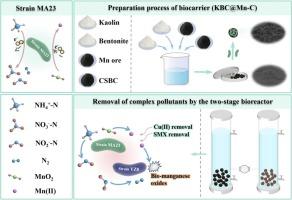当前位置:
X-MOL 学术
›
J. Hazard. Mater.
›
论文详情
Our official English website, www.x-mol.net, welcomes your
feedback! (Note: you will need to create a separate account there.)
Simultaneous removal of ammonia, copper ions and sulfamethoxazole from aquaculture wastewater with low carbon to nitrogen ratio enhanced by manganese redox driven by a two-stage synergistic bioreactor: Optimization and potential mechanism
Journal of Hazardous Materials ( IF 12.2 ) Pub Date : 2024-11-20 , DOI: 10.1016/j.jhazmat.2024.136586 Meng Cao, Yihan Bai, Yue Wang, Junfeng Su, Jingting Feng
Journal of Hazardous Materials ( IF 12.2 ) Pub Date : 2024-11-20 , DOI: 10.1016/j.jhazmat.2024.136586 Meng Cao, Yihan Bai, Yue Wang, Junfeng Su, Jingting Feng

|
The problem of low carbon-nitrogen ratio (C/N) in wastewater is a major challenge for biological treatment, especially the complex pollution of ammonia nitrogen (NH4+-N), sulfamethoxazole (SMX), and copper ions (Cu(II)). Herein, a strain of Pseudoxanthomonas sp. MA23 with manganese (Mn) reduction-coupled ammonia oxidation properties was isolated. Subsequently, kaolin and bentonite were used as the main raw materials, and a mixture of coconut shell biochar (CSBC) and different Mn ores were added to make ceramsite carriers to load the target strain MA23. To achieve complete N removal and Mn redox process, Dechloromonas sp. YZ8 with Mn redox and denitrification performance was introduced, and a second-stage bioreactor was constructed with volcanic rock as the biocarrier. The results showed that the bioreactor was most effective when the hydraulic retention time (HRT) was 20.0 and 2.0 h, C/N was 1.5, and pH was 6.5. The response of the bioreactors was investigated by inflowing different concentrations of Cu(II) and SMX. Appropriate Cu(II) concentrations promoted the electron transfer in the system, and Cu(II) and SMX were together removed by biological action and chemisorption. Furthermore, genes involved in N metabolism were enriched in the bioreactors and the microorganisms responded to environmental changes by up or down-regulating relevant metabolic genes. The synergistic system proposed in this study provided a promising attempt to simultaneously address NH4+-N-Cu(II)-SMX pollution in low C/N wastewater.
中文翻译:

通过两级协同生物反应器驱动的锰氧化还原以低碳氮比同时去除水产养殖废水中的氨、铜离子和磺胺甲噁唑:优化和潜在机制
废水中低碳氮比 (C/N) 问题是生物处理的重大挑战,尤其是氨氮 (NH4+-N)、磺胺甲噁唑 (SMX) 和铜离子 (Cu(II)) 的复杂污染。在此,分离出一种具有锰 (Mn) 还原偶联氨氧化特性的 Pseudoxanthomonas sp. MA23 菌株。随后,以高岭土和膨润土为主要原料,加入椰壳生物炭 (CSBC) 和不同 Mn 矿石的混合物,制成陶粒载体,加载目标菌株 MA23。为了实现完全脱氮和锰氧化还原工艺,引入了具有锰氧化还原和反硝化性能的脱氯单胞菌属 YZ8,并以火山岩为生物载体建造了第二段生物反应器。结果表明,当水力停留时间 (HRT) 为 20.0 和 2.0 h、C/N 为 1.5 和 pH 为 6.5 时,生物反应器效果最佳。通过流入不同浓度的 Cu(II) 和 SMX 来研究生物反应器的响应。适当的 Cu(II) 浓度促进了系统中的电子转移,Cu(II) 和 SMX 通过生物作用和化学吸附一起去除。此外,参与 N 代谢的基因在生物反应器中富集,微生物通过上调或下调相关代谢基因来响应环境变化。本研究中提出的协同系统为同时解决低 C/N 废水中的 NH4+-N-Cu(II)-SMX 污染提供了一个有前途的尝试。
更新日期:2024-11-20
中文翻译:

通过两级协同生物反应器驱动的锰氧化还原以低碳氮比同时去除水产养殖废水中的氨、铜离子和磺胺甲噁唑:优化和潜在机制
废水中低碳氮比 (C/N) 问题是生物处理的重大挑战,尤其是氨氮 (NH4+-N)、磺胺甲噁唑 (SMX) 和铜离子 (Cu(II)) 的复杂污染。在此,分离出一种具有锰 (Mn) 还原偶联氨氧化特性的 Pseudoxanthomonas sp. MA23 菌株。随后,以高岭土和膨润土为主要原料,加入椰壳生物炭 (CSBC) 和不同 Mn 矿石的混合物,制成陶粒载体,加载目标菌株 MA23。为了实现完全脱氮和锰氧化还原工艺,引入了具有锰氧化还原和反硝化性能的脱氯单胞菌属 YZ8,并以火山岩为生物载体建造了第二段生物反应器。结果表明,当水力停留时间 (HRT) 为 20.0 和 2.0 h、C/N 为 1.5 和 pH 为 6.5 时,生物反应器效果最佳。通过流入不同浓度的 Cu(II) 和 SMX 来研究生物反应器的响应。适当的 Cu(II) 浓度促进了系统中的电子转移,Cu(II) 和 SMX 通过生物作用和化学吸附一起去除。此外,参与 N 代谢的基因在生物反应器中富集,微生物通过上调或下调相关代谢基因来响应环境变化。本研究中提出的协同系统为同时解决低 C/N 废水中的 NH4+-N-Cu(II)-SMX 污染提供了一个有前途的尝试。


















































 京公网安备 11010802027423号
京公网安备 11010802027423号